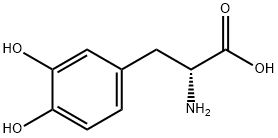LEVODOPA RELATED COMPOUND A (50 MG) (3-(3,4,6-TRIHYDROXYPHENYL)-ALANINE)
Synonym(s):2,5-Dihydroxy-L -tyrosine;3-(2,4,5-Trihydroxyphenyl)-L -alanine
- CAS NO.:27244-64-0
- Empirical Formula: C9H11NO5
- Molecular Weight: 213.19
- SAFETY DATA SHEET (SDS)
- Update Date: 2025-01-27 09:38:02

What is LEVODOPA RELATED COMPOUND A (50 MG) (3-(3,4,6-TRIHYDROXYPHENYL)-ALANINE)?
The Uses of LEVODOPA RELATED COMPOUND A (50 MG) (3-(3,4,6-TRIHYDROXYPHENYL)-ALANINE)
6-Hydroxy-L-DOPA is the 6-hydroxy derivative of the amino acid L-DOPA (D533751) with neurotoxic properties. Studies show that exogenously administered 6-Hydroxy-L-DOPA is biotransformed by amino acid decarboxylase to the highly potent and catecholamine-selective neurotoxin, 6-Hydroxydopamine. The treatment of 6-Hydroxy-L-DOPA in rats resulted in the stimulation of acetylcholinesterase.
The Uses of LEVODOPA RELATED COMPOUND A (50 MG) (3-(3,4,6-TRIHYDROXYPHENYL)-ALANINE)
6-Hydroxy-L-DOPA (Levodopa EP Impurity A; Levodopa USP Related Compound A) is the 6-hydroxy derivative of the amino acid L-DOPA (D533751) with neurotoxic properties. Studies show that exogenously administered 6-Hydroxy-L-DOPA is biotransformed by amino acid decarboxylase to the highly potent and catecholamine-selective neurotoxin, 6-Hydroxydopamine. The treatment of 6-Hydroxy-L-DOPA in rats resulted in the stimulation of acetylcholinesterase.
Definition
ChEBI: An L-alpha-amino acid that is L-dopa carrying an additional hydroxy substituent at position 6.
Properties of LEVODOPA RELATED COMPOUND A (50 MG) (3-(3,4,6-TRIHYDROXYPHENYL)-ALANINE)
| Melting point: | >190°C (dec.) |
| Boiling point: | 515.2±38.0 °C(Predicted) |
| Density | 1.606±0.06 g/cm3(Predicted) |
| storage temp. | Hygroscopic, -20°C Freezer, Under inert atmosphere |
| solubility | Aqueous Acid (Slightly, Sonicated), Water (Slightly, Heated, Sonicated) |
| pka | 2.34±0.25(Predicted) |
| form | neat |
| form | Solid |
| color | Brown to Black |
| Stability: | Air Sensitive, Hygroscopic |
Safety information for LEVODOPA RELATED COMPOUND A (50 MG) (3-(3,4,6-TRIHYDROXYPHENYL)-ALANINE)
| Signal word | Warning |
| Pictogram(s) |
 Exclamation Mark Irritant GHS07 |
| GHS Hazard Statements |
H302:Acute toxicity,oral H315:Skin corrosion/irritation |
| Precautionary Statement Codes |
P264:Wash hands thoroughly after handling. P264:Wash skin thouroughly after handling. P270:Do not eat, drink or smoke when using this product. P280:Wear protective gloves/protective clothing/eye protection/face protection. P332+P313:IF SKIN irritation occurs: Get medical advice/attention. P501:Dispose of contents/container to..… |
Computed Descriptors for LEVODOPA RELATED COMPOUND A (50 MG) (3-(3,4,6-TRIHYDROXYPHENYL)-ALANINE)
New Products
Methyl (R)-1-Boc-4,4-difluoropyrrolidine-2-carboxylate 2,2-Difluoropropylamine hydrochloride tert-butyl 3-bromoazetidine-1-carboxylate (R)-1-Boc-3-hydroxypyrrolidine DIFLUOROACETIC ANHYDRIDE 2,2-Difluoropropionic acid Diallylamine, 99% Calcium hydroxide, 95% Aluminum oxide, basic 2-Bromophenylacetonitrile, 97% L-tert-Leucine,97% N-Hydroxy-2-methylpropanimidamide 4-(3,4-Dichlorophenyl)-3,4-Dihydro-N-Methyl-1-(2H)-Naphthalenimine (Schiff Base) 2-AMINO-3,5-DIBROMO BENZALDEHYDE [ADBA] L-Glutamic Acid Dimethyl Ester Hcl 10-Methoxy-5H-dibenz[b,f]azepine 5-Cyanophthalide N, N-Carbonyldiimidazole (CDI) Dibenzoyl Peroxide Titanium Dioxide 2-(Methylthio) Benzonitrile Sodium Acetate Anhydrous Allopurinol 1,5-DibromopentaneRelated products of tetrahydrofuran








You may like
-
 Levodopa Related Compound A CAS 27244-64-0View Details
Levodopa Related Compound A CAS 27244-64-0View Details
27244-64-0 -
 Levadopa Related Compound A CAS 27244-64-0View Details
Levadopa Related Compound A CAS 27244-64-0View Details
27244-64-0 -
![Cis-2-(Bromomethyl)-2-(2,4-Dichlorophenyl)-1,3-Dioxolane-4-Ylmethyl Benzoate [CBB] 61397-56-6 99%](https://img.chemicalbook.in//Content/image/CP5.jpg) Cis-2-(Bromomethyl)-2-(2,4-Dichlorophenyl)-1,3-Dioxolane-4-Ylmethyl Benzoate [CBB] 61397-56-6 99%View Details
Cis-2-(Bromomethyl)-2-(2,4-Dichlorophenyl)-1,3-Dioxolane-4-Ylmethyl Benzoate [CBB] 61397-56-6 99%View Details
61397-56-6 -
 Ethyl-2-Chloroacetoacetate 609-15-4View Details
Ethyl-2-Chloroacetoacetate 609-15-4View Details
609-15-4 -
 CIS- BROMO BENZOATEView Details
CIS- BROMO BENZOATEView Details
61397-56-6 -
 609-15-4View Details
609-15-4View Details
609-15-4 -
![1-(6-Methylpyridin-3-Yl)-2-[4-(Methylsulfonyl)Phenyl]Ethanone [Ketosulfone] 99%](https://img.chemicalbook.in//Content/image/CP5.jpg) 1-(6-Methylpyridin-3-Yl)-2-[4-(Methylsulfonyl)Phenyl]Ethanone [Ketosulfone] 99%View Details
1-(6-Methylpyridin-3-Yl)-2-[4-(Methylsulfonyl)Phenyl]Ethanone [Ketosulfone] 99%View Details
221615-75-4 -
 27143-07-3View Details
27143-07-3View Details
27143-07-3
